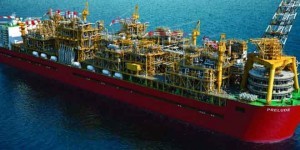By Charles Ellinas
Given the prospect of new gas discoveries in Cyprus’ EEZ, it is timely to review recent developments.
Floating liquefied natural gas (FLNG) scored some notable successes so far in 2017, to the extent that the world may be witnessing a resurgence of this technology.
The attainment of a number of successful milestones over the last few months is bringing interest back. In fact, 2017 is turning out to be a big year for FLNG.
Key FLNG milestones
By 2018, there will be three operating FLNG projects: Petronas’ PFLNG Satu, Perenco’s FLNG Hilli and Shell’s Prelude.
The world’s first FLNG vessel, known as PFLNG Satu, with a total LNG processing capacity of 1.2 million-tonnes-per-annum (mtpa) and an estimated cost of $1.6bn, positioned at the Kanowit gas-field off Sarawak is now operational. Petronas’ Satu project came on stream and started producing LNG early December and exported its first LNG early April.
Emboldened with this success, Petronas is proceeding with the construction of its second FLNG vessel, PFLNG-2, announcing in May that will be operational by 2020. It will be deployed at the Rotan field, 240km off Sabah in Malaysia, with a total LNG processing capacity of 1.5mtpa.
The second FLNG vessel to become operational, with 1.2mtpa LNG capacity, will be for the Kribi gas-field offshore Cameroon, operated by Perenco and Cameroon’s SNH.
Golar is supplying the unit, known as FLNG Hilli Episeyo. It is also the first LNG carrier to be converted into an FLNG unit. It is aiming to start production in September.
Golar plans to follow this up with the Fortuna FLNG vessel to be installed in Ophir Energy’s block-R, about 100km offshore Equatorial Guinea. Fortuna’s LNG capacity will be 2.5mtpa and it is scheduled to become operational in 2020. FID is expected in August.
The next milestone will be Shell’s Prelude FLNG. After sailing 5,550km from Korea, it is now at location at the Prelude gas-field, 475km offshore Western Australia, where it will stay for 25 years. At 600,000 tonnes it is the biggest floating structure ever constructed, with staggering dimensions of 488m by 74m, at a total cost of about $12.6bn. It will be producing 3.6mtpa LNG and it is expected to start operating in 2018. It should be noted that this cost includes facilities to produce 5.3mtpa liquids, 1.3mtpa condensate and 0.4mtpa LPG. It is a prototype that the industry is watching with great interest.
Another important milestone is Eni’s FID for Coral FLNG, in Mozambique, taken in June. The importance of this lies in the fact that FID has been taken in a low price environment, a strong indication that the FLNG concept can be viable even at low prices.
Coral FLNG will have an LNG capacity of 3.4mtpa. In October 2016, Eni and its Area 4 partners signed an agreement with BP for the sale of the entire volumes of LNG produced by the project for a period of over 20 years.
These partners will, once cleared, include ExxonMobil, which bought 50% of Eni’s share in March.
Where Coral FLNG is a first, is the water-depth. It will operate in 2,000m, making it the first ever ultra-deep-water FLNG. By comparison, Shell’s Prelude FLNG will be in a water-depth of about 250m. Start-up is expected mid-2022, with about 5tcf gas to be produced over 20 years.
This has great similarities to Aphrodite gas-field in Cyprus EEZ and, if drilling is successful, to potential gas-fields in Total’s Block 11. As result, development of Coral FLNG is of great importance to Cyprus’ aspirations to export its gas.
Not many LNG projects have reached FID during the last two years, reflecting the oversupply of LNG in the market. But the two projects sanctioned this year, Coral and Fortuna, are both FLNG projects. According to Wood McKenzie this highlights a positive shift in industry perception toward FLNG. Majors like Eni, ExxonMobil and BP have all now endorsed FLNG in a low LNG price environment. With stranded gas resources suited to FLNG elsewhere in the world, FLNG appears to be regaining support, especially where through standardisation construction costs are minimised.
Ask me anything
Explore related questions





